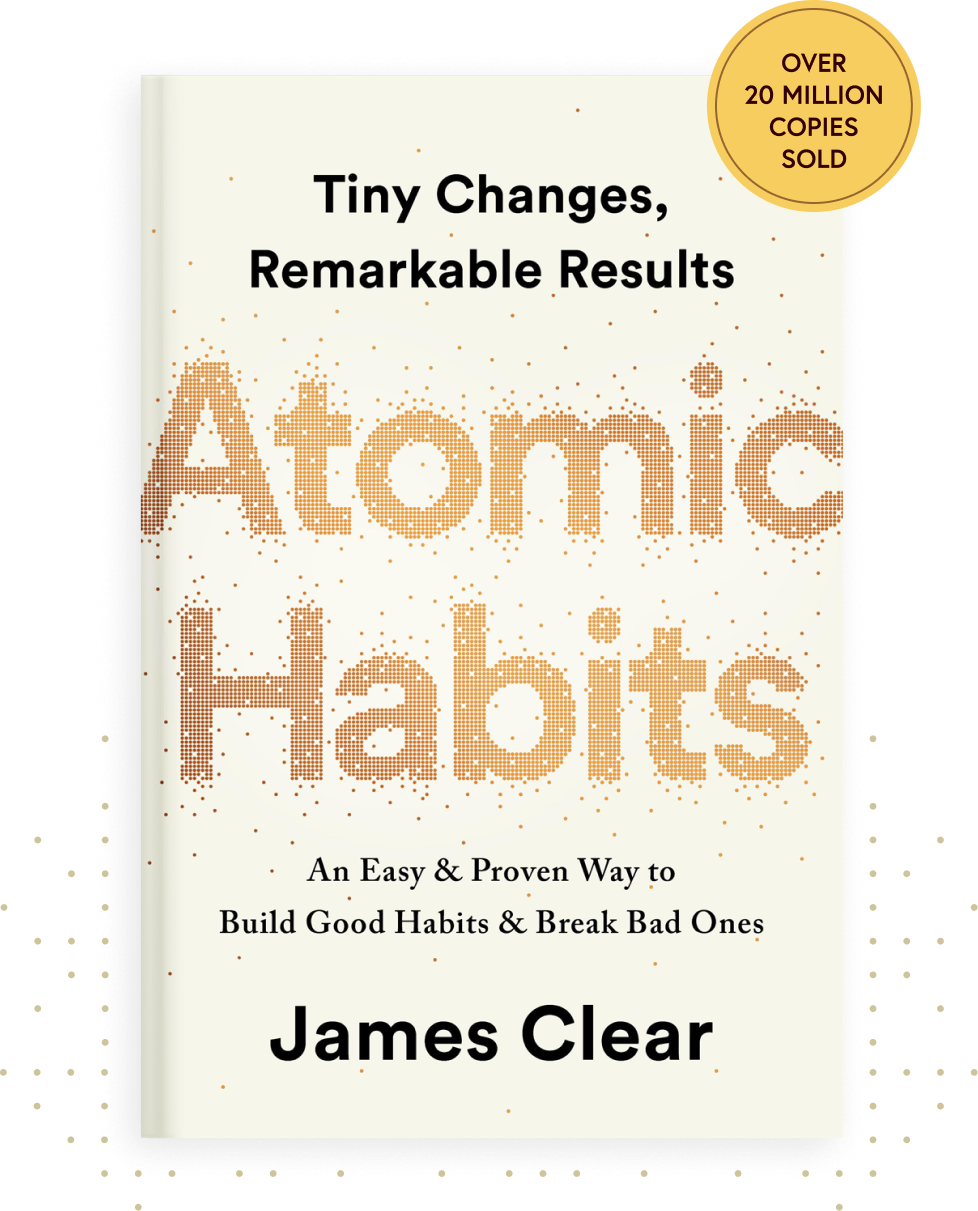
Memorable Quotes
- Habits create the foundation for mastery.
- Habits are the compound interest of self improvement.
- Success is the product of daily habits—not once-in-a-lifetime transformations.
- Bad habits repeat themselves again and again not because you don’t want to change, but because you have the wrong system for change.
- Happiness is the state you enter when you no longer want to change your state.
- The trick to doing anything is first cultivating a desire for it.
- Being poor is not having too little, it is wanting more.
- Good habits make time your ally. Bad habits make time your enemy.
- Habits are, simply, reliable solutions to recurring problems in our environment.
- Sometimes success is less about making good habits easy and more about making bad habits hard.
- The most effective form of motivation is progress.
- Never miss twice. If you miss one day, try to get back on track as quickly as possible.
- Humans experience peak motivation when working on tasks that are right on the edge of their current abilities
- The only way to become excellent is to be endlessly fascinated by doing the same thing over and over. You have to fall in love with boredom.
- Professionals stick to the schedule; amateurs let life get in the way.
- Until you make the unconscious conscious, it will direct your life and you will call it fate.
- The best is the enemy of the good.
- Missing once is an accident. Missing twice is the start of a new habit.
- Whenever you want to change your behaviour, you can simply ask yourself: How can I make it obvious? How can I make it attractive? How can I make it easy? How can I make it satisfying?
- Goals are good for setting a direction, but systems are best for making progress.
- You do not rise to the level of your goals. You fall to the level of your systems.
- In order to improve for good, you need to solve problems at the systems level. Fix the inputs and the outputs will fix themselves.
Why I Picked Up This Book
- What drew me to this book was a simple question : How do I stick to the habits I truly want? I have always felt that I am good at managing good and bad habits but when it comes to the ones that I really aspire to build - I often fell struggled to hold onto them.
- Goals give us direction, but its the system’s we follow that really help us to progress in life. What I was curious about was - How do we build such systems? What is the science behind making them work.
- Bad habits tend to stick around far more stubbornly than good ones. Why is that? We categorize them as good/bad but if we remove that label, What makes certain behaviors so effortless to hold on to? And how does our brain play a role in reinforcing them?”
- Habits are automations that are run by the subconscious, requiring little thought or effort. They free up our mental space and quietly shape the way we live and grow. Therefore it was my natural curiosity to understand the science behind them.
Personal Reactions
Honestly, I found this book incredibly fascinating. It helped me pinpoint several issues in my daily routine that were holding back my progress. What stood out to me was the wide range of case studies—from athletes and business coaches to medical professionals—which gave different perspectives and made the concepts easier to relate to and understand.
The idea of identity-based habits really struck a chord with me. When I read about it, something just clicked. There’s a huge difference between saying “I’m learning System’s Programming” _ and _ “I’m a System’s programmer.” Adopting the latter as part of my identity has given me the confidence to explore challenging and uncertain paths.
Techniques like habit stacking and temptation bundling offer practical formulas I could immediately apply. This is a big relief as instead of drawing in the air, I can rely on a framework that has helped several people. The emphasis on collecting evidence to reinforce identity has also been incredibly valuable. I am using obsidian for tracking my habits.
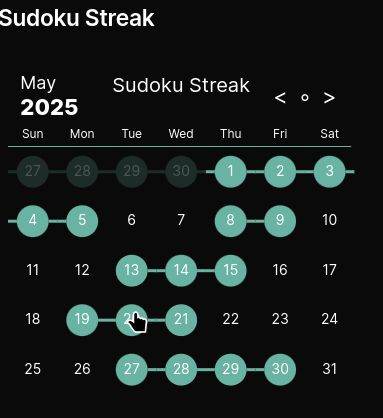
This has been really helpful as via my journal, I identified why I didn’t perform the habit on certain days and then make amendments to my daily lifestyle to become punctual.
Along with that tools like the two-minute rule and the Goldilocks rule have helped me focus better and actually complete tasks.
I even experimented with a habit contract with some friends, and surprisingly, it worked. This not only helped me hold onto my habits but also helped me gain confidence in myself.
The concept of improving just 1% every day is simple yet powerful. I also appreciate the strategies for breaking bad habits—especially the inversion of the laws of behaviour change, which made the process feel manageable and structured.
This book already overlaps a lot with BASB(Building a Second Brain) which was nice and helpful.
Overall, I think the one thing I genuinely loved taking away from this book is “The Idea of Identity Based Habit Building”. It way eye opening and is helping me restructure my approach towards everyone and everything in life.
Quick Summary
Atomic Habits is a practical guide to understanding, building and breaking habits. It briefly talks about the science behind habit formation and offers a number of case studies for understanding and applying these concepts in real life. It also emphasises on identity based habits and systems rather than goals setting. Along with that this book also offers the Four Laws of Behavioural Change that are associated with the Habit Loop (Cue, Craving, Response, Reward). This book also offers a number of rules, tools and formula’s that you can incorporate into your daily life to manage your habits efficiently. It also offers a good framework for habit tracking. Along with that it also gives a number of strategies to make certain habits exciting which are boring in nature but are required. This book also goes in great length’s about how small improvements can have a major impact in your life. Overall this book will help you to reduce procrastination, identify yourself and help become productive in life.
Things that I find interesting about this book
THE SCIENCE OF HOW HABITS WORK (Habit Loop)

- Cue triggers your brain to initiate a behavior.
- Cravings are the motivational force behind every habit.
- The third step is the response. The response is the actual habit you perform, which can take the form of a thought or an action.
- Finally, the response delivers a reward. Rewards are the end goal of every habit.
- Rewards satisfy our craving.
- They teach us which actions are worth remembering in future.
- cue→ craving → response → reward form a neurological feedback loopthat ultimately allows you to create automatic habits. This cycle is known as the habit loop.
THE FOUR LAWS OF BEHAVIOR CHANGE
Creating a Good Habit
- Make It Obvious (Cue)
- Make It Attractive (Craving)
- Make It Easy (Response)
- Make It Satisfying (Reward)
Breaking a Bad Habit
- Make It Invisible (Cue)
- Make It Unattractive (Craving)
- Make It Difficult (Response)
- Make It Unsatisfying (Reward)
Identity Based Habit Building
Your habits shape your identity, and your identity shapes your habits. Instead of building habits for achieving a goal, we must build habit as a part of our identity.
Example : I am trying to quit smoking vs I am a non smoker
(Images from Atomic Habits)
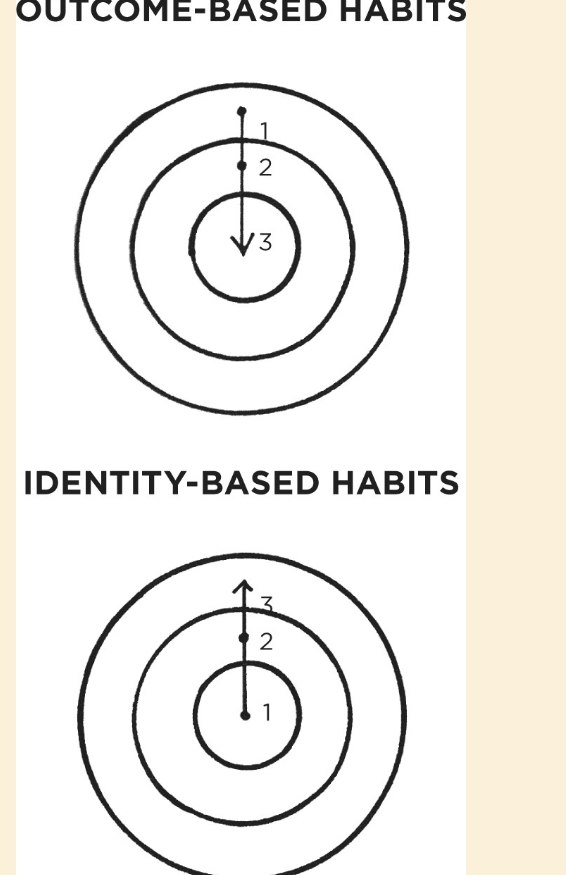
- Your behaviors are usually a reflection of your identity. What you do is an indication of the type of person you believe that you are—either consciously or nonconsciously.fn1 Research has shown that once a person believes in a particular aspect of their identity, they are more likely to act in alignment with that belief.
- Instead of focusing on goals, we must focus on the systems that lead towards this goal.
- The more we perform these habits, the more evidence we are giving to ourselves regarding this identity. This will also help us keep motivated
Two Step Process To Change Your Identity
- It is a simple two-step process:
- Decide the type of person you want to be.
- Prove it to yourself with small wins.
The Habit Contract
It is a verbal or written agreement in which you state your commitment to a perticular habit and the punishment that will occur if you don’t follow through.
Example : You can create a habit contract that states that you will pay your gym instructor ₹500 for everyday that you dont attend the gym 🥲
We care about the opinions of those around us because it helps if others like us. This is precisely why getting an accountability partner or signing a habit contract can work so well.
Commitment Device
A commitment device is a choice you make in the present that controls your actions in the future. Commitment devices increase the odds that you’ll do the right thing in the future by making bad habits difficult in the present.
Example : Paying for a gym membership in advance to force yourself to attend regularly. Sharing your goals with your friend in order to be accountable (Maybe a Habit Contract).
Temptation Bundling
Templtation Bundling is a way of performing those habits, that we procastinate on often. Just like Habit stacking stacking, the idea works by linking an action you want to do with an action you need to . In simple terms, we link a fun activity against a boring one and only allow to do the fun activity, if we complete the boring one.
The underlying idea is to make the habit attractive. Habits are a domain driven feedback loop and not all habits are attractive, therefore strategies like this can be used to make a habit attractive and get more dopamine release.
Desire is the engine that drives behavior. Every action is taken because of the anticipation that precedes it.
We can also combine Habit Stacking with Temptation Bundling and get a formula
After [CURRENT HABIT], I will [HABIT I NEED]. After [HABIT I NEED], I will [HABIT I WANT]
Example : I will only eat from my favourite restaurant, when I implement a feature for my side project I will only watch youtube when I have completed my TODO list for the day
Habit Stacking
Habit Stacking is a powerful technique to build new habits by stacking them together. The idea is based on the Diderot Effect which states that *obtaining a new possession often creates a spiral of consumption that results in acquisition of even more possessions *.
Example : Buying a new phone may lead lead to buying a case, screen protector and ear buds
Basically it leverages the idea that our behaviours often follow a chain reaction - once we start its easier to keep going. You could, for example, start with easier habits and stack difficult habits on top of the easier habit to make it easy to perform that habit.
The habit stacking formula is
“After [CURRENT HABIT], I will [NEW HABIT].”
(Images from Atomic Habits)
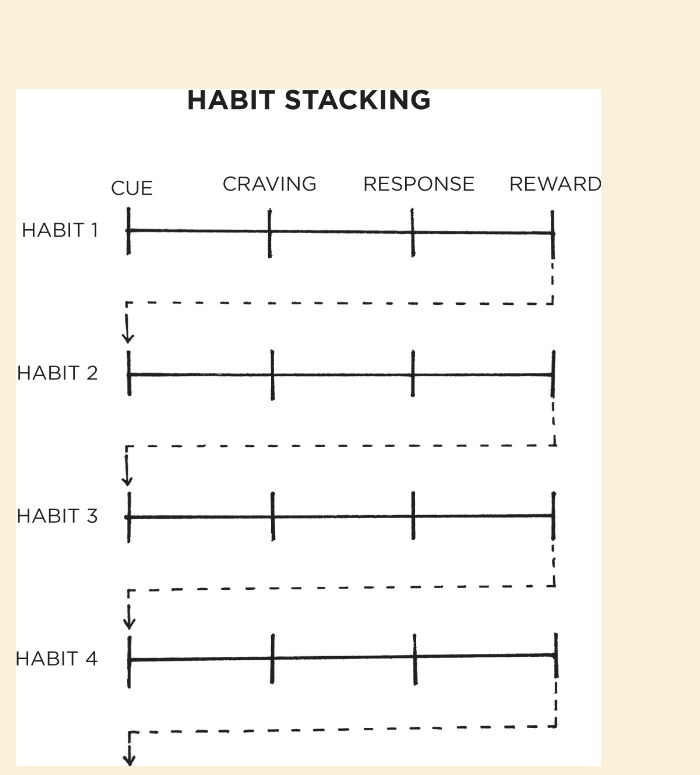
Example : After boarding the train for work, I will solve 5 puzzles of sudoku and then I will read one chapter of Atomic Habits.
Implementation Intention
It is a plan you make beforehand about when and where to act. That is, how you intend to implement a particular habit. In layman’s terms make write down your habits in a clear unambiguous way. That will make it more likely to be followed.
“When situation X arises, I will perform response Y.”
Basically cues like time and location must be clearly defined for an habit and not be ambiguous.
Example : After boarding the train for work, I will solve 5 puzzles of sudoku instead of
I will solve 5 puzzles of sudoku in the morning
The Two Minute Rule
The Two Minute Rule states that Once you start a new Habit, it should take less than 2 minutes to do so
It is an excellent way to avoid procastinating a habit and relies on the fact that habit must be established before it can be improved. If the habit is initially easy to perform, then there is a very high chance that we will perform it. We can utilize this to build up our habit and then optimize it.
Standardize before you optimize. You can’t improve a habit that doesn’t exist.
When we are performing an habit, even if its just two minutes in the beginning, we are enforcing that identity onto ourselves. We are basically creating evidence that yes, this is our identity, this is who I am. Once that sets in, we can slowly increase the time and it would be much easier to enforce that habit.
Example : If you want to become a reader, then create a habit where you read 1 page of the book you are interested in. After sometime, you will have enough evidence to say that you are a reader and therefore you will automatically increase the reading time.
Law of Least Effort
Habits are easier to build when they fit into the flow of your life. The idea behind Law of Least Effort is to modify your environment in such a way that it there is very little to no friction when performing an habit.
Example : Creating an Archipelago of Ideas (BASB) before writing the book review to make it easier to work on the book review Writing a TODO forUsing the Hemingway’s bridge to plan for next session of your task, so that its easy to work on that task.
Goldilocks Rule
Goldilocks Rule tells us, how to stay motivated at life and work. It states that humans experience peak motivation when working on tasks that are right on the edge of their current abilities. The greatest threat to success is not failure but boredom. Its based on Yerkes–Dodson law, which describes the optimal level of arousal as the midpoint between boredom and anxiety.
Basically design your habits in such a way that they are a little bit above your ability but not too much.
Small Habits Make Big Improvement
Habits are the compound interest of self improvement. If you introduce small habits regularly and try to improve by atleast 1% then slowly you will start seeing the improvements in yourself.
(Images from Atomic Habits)
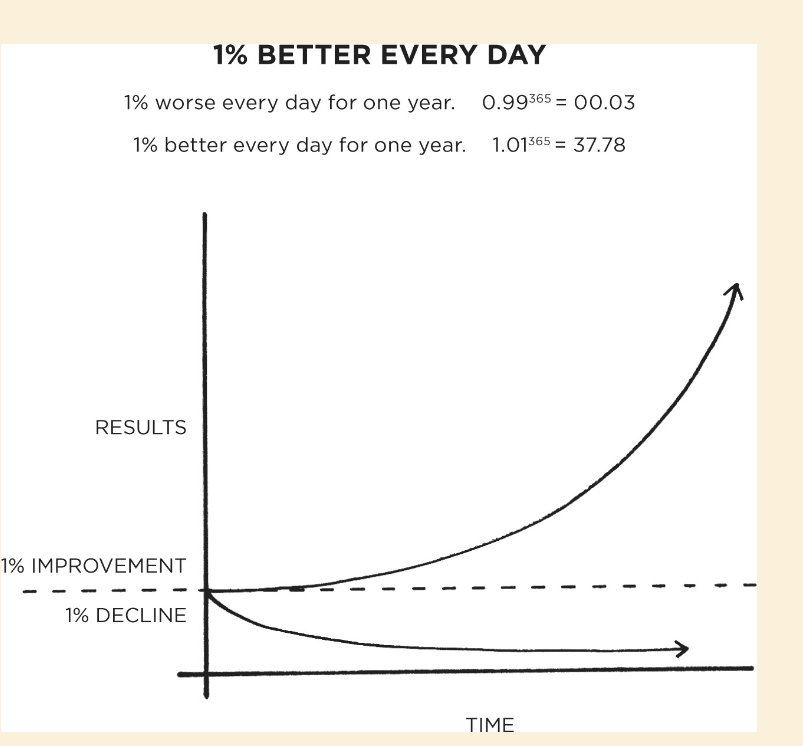
Basically adding and performing these small habits again and again results in providing more and more evidence towards our identity.
Parallels to other popular works
This book overlaps with the ideas present in Deep Work by New Calport, GTD by David Allen, Building a Second Brain by Tiago Forte, The Power Of Habit by Charles Duhigg.
Wrapping (Do I recommend it or not)
Yup 100% I would recommend this to anyone who wishes to be productive in life and build a framework for managing, creating and destroying habits.